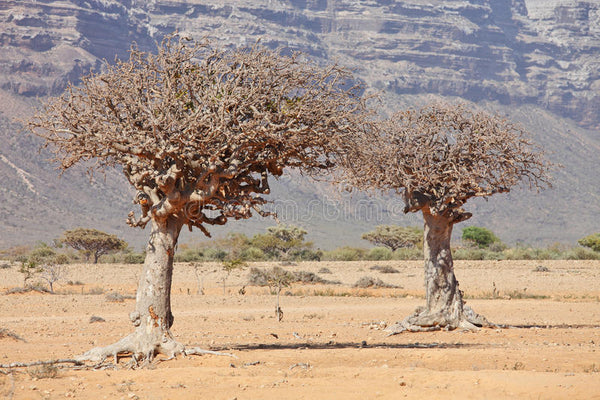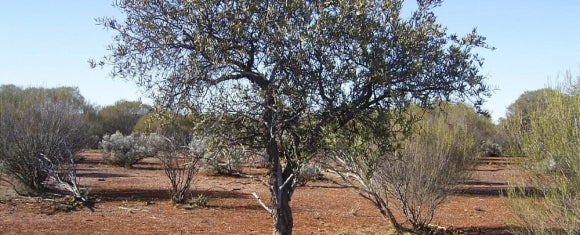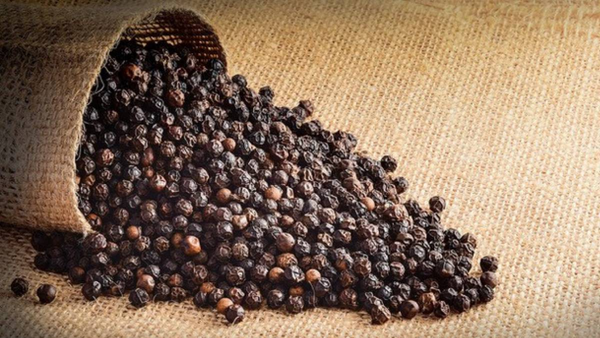
10 ml
Myrrh is the dried sap of a tree and is commonly referred to as resin. It has been used for offerings and healing since antiquity and is still used in the same fashion today. This tree grows naturally in the drier parts of Africa, Arabia, Madagascar, and India, and as the demand for this resin grew too great for wild harvest, plantations were established in southern Arabia. A contributing aspect of this was the domestication of camels in second millennium BCE, allowing large caravans to cross the oceanic Arabian desert, bringing myrrh to Babylon, and the port cities of Israel and Phoenicia, and from there myrrh was shipped all over the ancient world.
Queen Hatshepsut of Egypt, was so enchanted by myrrh she sent an expedition to the land of Punt (the land of Punt is fascinating in that, the location was kept so secret, that no maps have been found, although it is well documented by Hatshepsut and King Sahure among others) not only to bring back to resin but 31 living trees! This being the oldest recorded tree transplantation. Daily worship of the sun god Ra, included burning golden resin at dawn, myrrh at noon, and at sunset a combination of frankincense, honey, and wine symbolic of perfect harmony. An ingredient in the famous temple incense blend kyphi, and used in embalming and deification mysteries of the dead.
In the Greek legend of Adonis, the lover of Aphrodite, he was born from a myrrh tree. We still use the phrase ‘he is an Adonis’ to suggest that someone is impossibly handsome. Ovid describes how Adonis’ mother, Smyrra, was transformed into this tree to show her repentance: “Although along with her shape she has also lost her emotion, she cries, and hot tears flow from the tree. The tears, too, have their honor – the myrrh which drops from the wood carries the name of this lady, and she will always be remembered.” Myrrh was used to venerate The Great Mother Goddess: Isis (Egypt), Ishtar (Mesopotamian) and Astarte (Phoenician).
At Sinai, God commanded Moses to have frankincense and myrrh blended with spices into fine oils for anointing and consecration (Exodus 30:37). Nicodemus brings “a mixture of myrrh and aloes” with which to prepare Jesus’ body for burial (John 19:39). In Exodus (30:22-9) The Lord commanded Moses to blend liquid myrrh, cinnamon, calamus and cassias in olive oil to be ‘the sacred anointing oil’ for the Ark of the Covenant, the alter and the priests. The Magi presented the baby Jesus with frankincense symbolic of his divinity, myrrh, his future death on the cross, and gold honoring him as king. To this day myrrh is an important part of Catholic Mass (the incense blend is myrrh, frankincense and benzoin) Mr. Herrera beautifully proclaims: “The Catholic faith is a liturgical faith. It makes use of all five of our senses: sight, sound, smell, taste, and touch. This is certainly by design as each sense aids us in availing ourselves of the salvific grace flowing from the Holy Sacrifice of the Mass. This is precisely why every effort should be used to employ all of our senses whenever possible during the celebration of the sacred liturgy.”
As you can see from above, myrrh holds the energy of redemption, death, morning, resurrection, reverence, and being elevated.
Folk Wisdom: Helps relieve pain from arthritis, rheumatism, muscle spasms and painful menses. Soothes coughs and bronchitis. It is astringent, analgesic, expectorant, antiseptic and anti – fungal. Wonderful for mature skin and the prevention of wrinkles
….
PART USED ~ Resin
EXTRACTION METHOD ~ Steam Distilled Essential Oil
ORIGIN ~ Somalia
NOTE CLASSIFICATION ~ Base Note, Fixative







